Hallucination: Definition, Causes, Types and Treatments
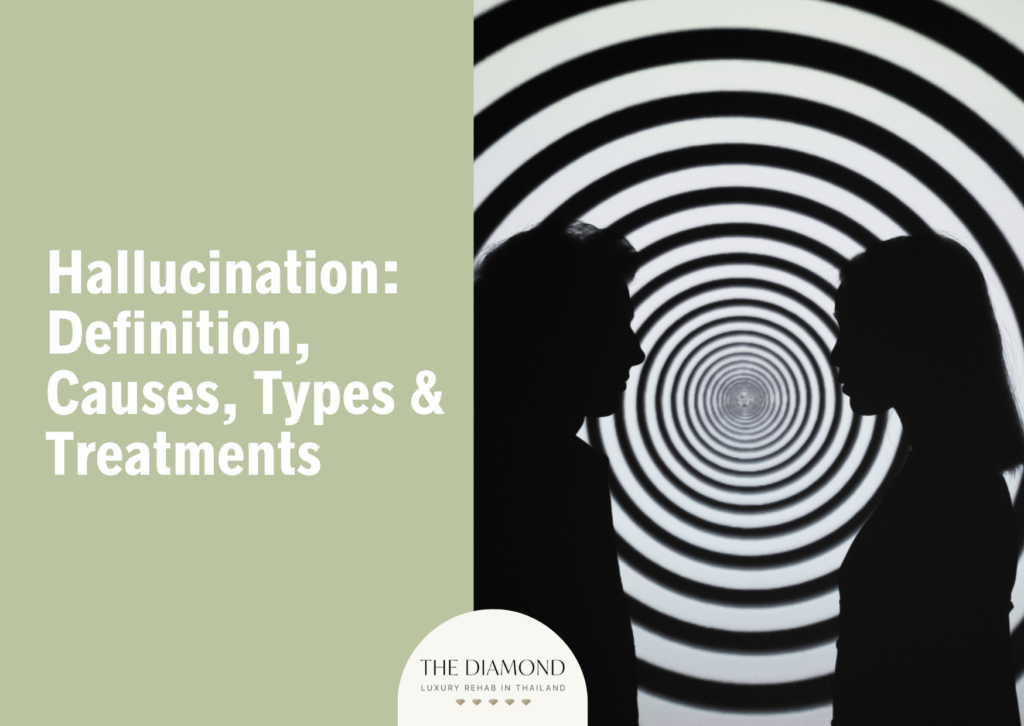
Hallucinations are defined as false perceptions of reality that make people see or hear and feel things that aren’t there. To the affected person, hallucinations are real i.e., they don’t realize they’re hallucinating. Hallucination is not a disease on its own, but it’s a sign of a serious problem that requires a comprehensive treatment program and proactive management.
The causes of hallucinations can be physical and psychological. Common physical causes of hallucinations are drugs (both prescription and illicit drugs), alcohol, Alzheimer’s disease, and Parkinson’s disease. Mental health conditions can also lead to hallucinations with schizophrenia being the most common cause. In fact, many people assume hallucinations occur due to schizophrenia only, but it’s not true. Other mental health conditions that cause hallucinations include bipolar disorder, delusional disorder, brief psychotic disorder, schizophreniform disorder, and schizoaffective disorder.
The most common hallucination types are auditory and visual hallucinations, which involve hearing or seeing things that aren’t there, respectively. Other types of hallucinations include olfactory, tactile, and gustatory hallucinations. These include hallucinating smells, sensations, and tastes, respectively. In addition, people can have proprioceptive and presence hallucinations as well as hypnopompic and hypnagogic hallucinations.
Treatments for hallucinations depend on the underlying cause. In most cases, patients need medications and counseling.
What is a Hallucination?
Hallucination is a false perception of sensory experiences. It is a perception of a nonexistent voice, object, or sensation that isn’t caused by stimulation of the relevant sensory organs. People with hallucinations see, hear, or feel things that aren’t there. Hallucinations are vivid and clear with the full force and impact of normal perceptions. They aren’t under voluntary control.
In other words, a person doesn’t voluntarily start hallucinating and they can’t stop hallucination.
Sometimes hallucinations are normal. Good examples are those that people experience when waking up or falling asleep. However, other hallucinations could indicate the presence of some problem.
Hallucination isn’t a standalone disease, but a symptom or consequence of some physical or psychological issue.
Even though people have experienced hallucinations throughout history, the word hallucination was first introduced into the English language in 1646 by the 17th-century physician Sir Thomas Browne. The word stems from the Latin term alucinari, which means to wander in mind.
Hallucinations constitute one of five symptom domains of psychotic disorders in the Diagnostic and Statistical Manual of Mental Disorders, fifth edition (DSM-5) by the American Psychiatric Association. However, other health problems can cause them as well.
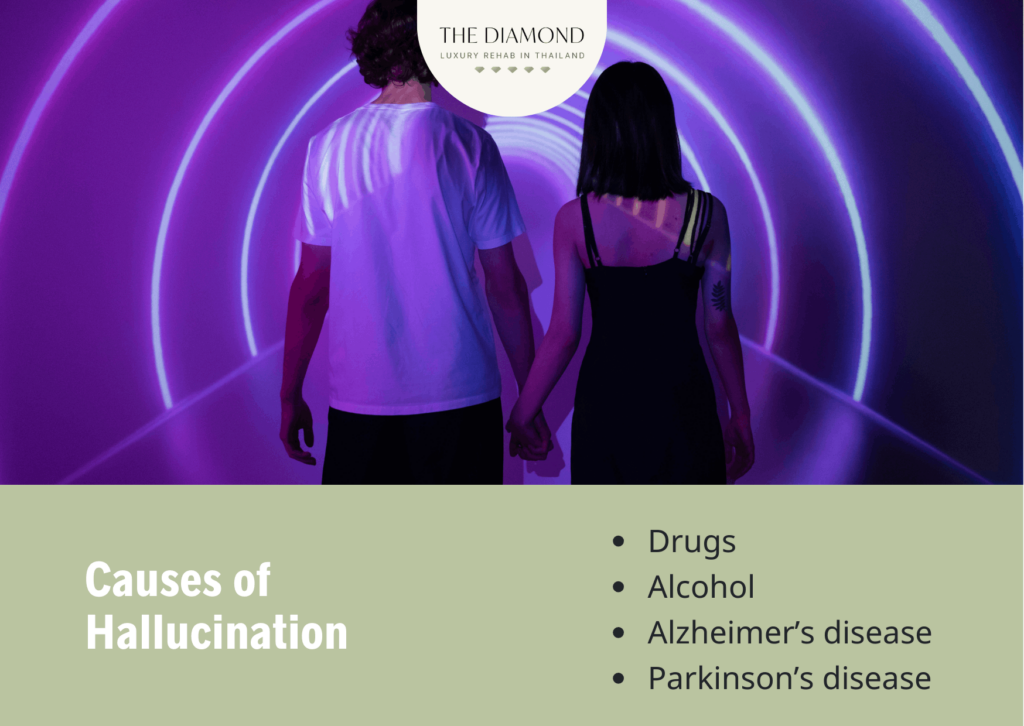
What causes Hallucinations?
The causes of hallucinations can range from neurological conditions and substance abuse to mental health problems. It’s not entirely known what causes hallucinations. Two people can have hallucinations that result from entirely different reasons. The biggest causes of hallucinations are listed below:
- Drugs
- Alcohol
- Alzheimer’s disease
- Parkinson’s disease
1. Drugs
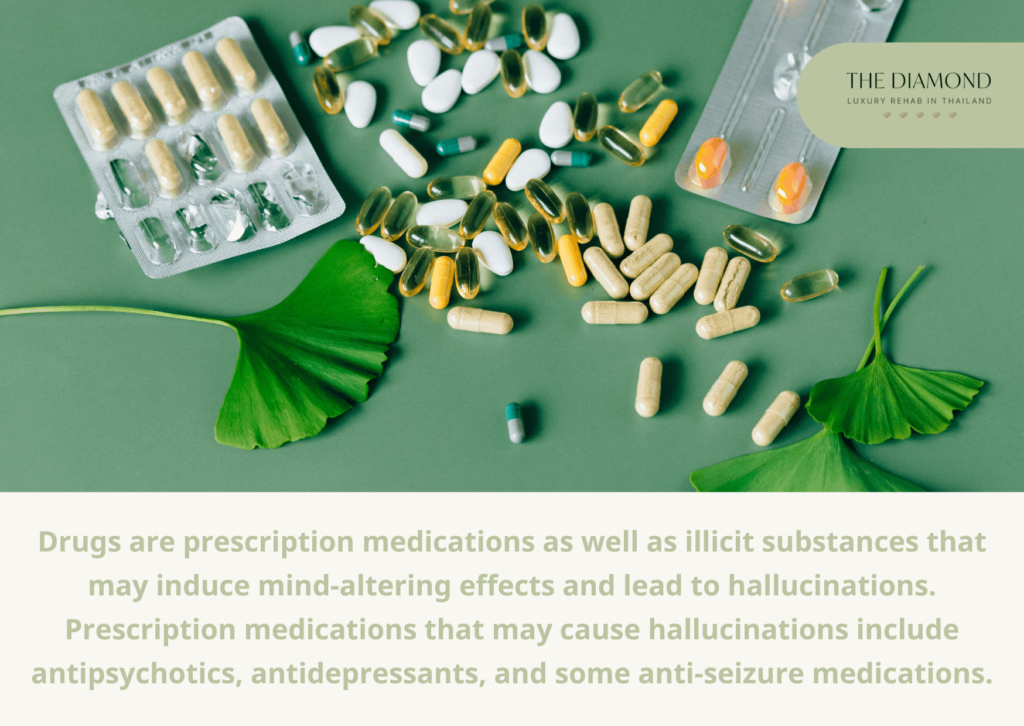
Drugs are prescription medications as well as illicit substances that may induce mind-altering effects and lead to hallucinations. Prescription medications that may cause hallucinations include antipsychotics, antidepressants, and some anti-seizure medications, just to name a few.
This may seem confusing because antipsychotics are prescribed for the treatment of psychosis and its symptoms. They work by changing brain chemistry to reduce psychotic symptoms such as hallucinations. Sometimes antipsychotics can cause relapse because their activity in blocking dopamine receptors can produce a compensatory state of dopamine supersensitivity. This leads to psychotic symptoms such as hallucinations, according to a paper from Therapeutic Advances in Psychopharmacology.
Antidepressants can lead to hallucinations directly by blocking dopamine reuptake and indirectly by stimulating postsynaptic receptors, explains the study from The Journal of Neuropsychiatry and Clinical Neurosciences.
Anti-seizure medications may produce hallucinations by acting on brain areas such as the hippocampus. Most people experience auditory or visual hallucinations.
Besides prescription medications, other drugs can cause hallucinations too. This is particularly present in people who use hallucinogenic drugs such as ecstasy, LSD, ketamine, psilocybin, PCP, cannabis, and others.
Hallucinogenic drugs cause hallucinations by interrupting the normal metabolic functions associated with how the brain receives information from sensory inputs or external stimuli. These substances suppress neural signals from the senses while a person who uses them is awake. When that happens, the conscious part of the brain gains access to memories for sensory analogs. While doing so it relies on experiences from the recent past to compensate or as a replacement for sensory inputs in the present moment. Information becomes mixed up in the process. At the same time, the feeling of being stimulated feels realistic to the person.
It’s also useful to mention that some hallucinogenic substances such as psilocybin amplify sensory inputs instead of suppressing them. This also leads to hallucinations.
2. Alcohol

Alcohol consumption can also cause hallucinations, especially when people drink high amounts of alcohol regularly. In other words, having a drink or two isn’t likely to cause hallucinations, but chronic abuse may lead to these sensory experiences, especially in people with mental illness.
It’s not entirely clear how alcohol causes hallucinations. It could be due to heightened dopamine activity alongside lowered serotonin levels, higher beta-carbolines, and an impaired auditory system. All these things could explain the presence of hallucinations.
When discussing alcohol as a cause of hallucinations, it’s important to mention alcoholic hallucinosis. In a nutshell, alcoholic hallucinosis is a rare alcohol-induced psychotic disorder almost exclusively observed in chronic alcoholics.
Alcohol misuse causes psychotic symptoms through several mechanisms of action, such as direct intoxication, alcohol withdrawal, delirium tremens, alcoholic dementia, and dependence on alcohol.
Hallucinations associated with alcohol intake are usually auditory and in the third person. They are often derogatory or commands and occur in clear consciousness.
3. Alzheimer’s disease
Alzheimer’s disease is a progressive neurologic condition indicated by brain atrophy (shrinking) and the death of brain cells. As the most common form of dementia, Alzheimer’s disease affects 6.5 million Americans over the age of 65 in 2022. Estimates show 12.7 million people age 65 and older will have Alzheimer’s disease by 2050, according to the Alzheimer’s Association.
This neurologic condition leads to cognitive decline and affects the way a person thinks or behaves. The most significant symptoms are memory loss, difficulty concentrating and thinking, impaired decision-making, difficulty planning or performing tasks, and changes in personality and behavior.
Complex changes take place in the brains of people with Alzheimer’s disease. For that reason, the affected individuals may hear or see things that others can’t. In other words, they may hallucinate.
Hallucinations tend to occur in the later stages of Alzheimer’s disease. The person may see the face of their old friend or insects crawling on their hand. A patient may hear someone’s voice and even engage in conversation with the other person that nobody else can see.
Visual hallucinations are the most common type of hallucinations that people with Alzheimer’s disease and dementia experience. These hallucinations usually occur due to damage to the brain. Patients with Alzheimer’s disease can also experience hallucinations due to other factors such as fever, stroke, seizure, infection, and migraine. Any disease that causes infection and inflammation can lead to hallucination as it interferes with brain function and leads to delirium.
Hallucinations are particularly distressing for people with Alzheimer’s disease because they leave them feeling frightened and in need of support.
4. Parkinson’s disease
Parkinson’s disease is a progressive neurologic disorder indicated by uncontrolled and unintended movements such as stiffness, shaking, and difficulty with coordination and balance. Symptoms of Parkinson’s disease tend to occur gradually, but they worsen with time. As the disease keeps progressing, it affects how a person talks and walks. Common symptoms of Parkinson’s disease include tremors, slowed movement (bradykinesia), rigid muscles, impaired balance and posture, loss of automatic movements, speech changes, and writing changes.
People with Parkinson’s disease may experience psychotic symptoms such as delusions and hallucinations. These symptoms are more prevalent in the advanced stages of the disease. Hallucinations usually occur as a side effect of medications that treat this progressive condition.
People with Parkinson’s disease usually have visual hallucinations. Auditory hallucinations can also occur which typically are non-verbal, with muffled or undistinguishable sounds. Besides medication side effects, other mechanisms are also involved in the development of hallucinations among patients with Parkinson’s disease.
For example, Parkinson’s hallucinations could result from a shift in the dominance of different networks. There could be a breakdown in brain networks associated with perception and attention. Additionally, hallucinations may occur due to a failure to integrate sensory information with prior knowledge. That means hallucinations result from overinterpretation of visual input and a brain area called the thalamus could be involved here.
Like Alzheimer’s disease, infections such as pneumonia can act on the brain and contribute to symptoms of psychosis, including hallucinations. Elevated activity of the brain neurotransmitter dopamine is also involved in the development of hallucinations in people with Parkinson’s disease.
What are the mental health conditions that may cause Hallucinations?
Mental health conditions that may cause hallucinations are typically disorders that involve some form of disconnection from reality or extreme imbalance between moods. The main mental health condition that causes hallucinations is schizophrenia.
In fact, the term hallucination makes an automatic connection with schizophrenia in our minds. But, it’s not the only cause of this sensory experience. The most common mental health conditions that cause hallucinations are listed below:
- Schizophrenia
- Bipolar disorder
- Delusional disorder
- Brief psychotic disorder
- Schizophreniform disorder
- Schizoaffective disorder
1. Schizophrenia
Schizophrenia is a serious mental disorder where people have an abnormal perception or interpretation of reality. This mental health illness affects the way a person thinks, feels, and behaves. It is indicated by continuous or relapsing episodes of psychosis. There are different types of schizophrenia, but the most common one is paranoid schizophrenia. People with this condition usually experience symptoms such as hallucinations, delusions, and paranoia.
The exact reason why schizophrenia causes hallucinations is unclear. A paper from the Journal of Psychiatry and Neuroscience explained that patients with schizophrenia have impaired modulation of thalamocortical gamma activity by external sensory input. As a result, the attentional mechanisms strongly contribute to the absence of sensory input. This could lead to hallucinations.
Even though a lot more research on this subject is necessary, it appears that schizophrenia leads to hallucinations by altering activity in the neural circuitry of some brain areas, such as language processing regions. It’s important to keep in mind that thalamocortical fibers relay motor or sensory information from the thalamus to specific areas in the brain.
Additionally, the thalamus in people with schizophrenia tends to be smaller than in people who don’t have this psychiatric condition. It’s a possibility that there is a link between the onset of auditory hallucinations and overly-intense neuronal connectivity in the relation thalamus – auditory cortex.
Healthline reports hallucinations may occur due to spontaneous activation in certain parts of the brain. These activations trigger sensory details linked to hallucinations. Additionally, people with schizophrenia have increased activity in certain regions of the brain such as the hypothalamus and paralimbic regions. On the other hand, activity in other places such as temporal lobes is decreased. Levels of the neurotransmitter dopamine could also play a role. Positive symptoms of schizophrenia, such as hallucinations, are linked to high dopamine levels in the mesolimbic pathway, which is integral to the brain’s reward system.
More precisely, schizophrenia leads to hallucinations due to changes in brain structure, chemistry, and processing.
2. Bipolar disorder
Bipolar disorder is a mental illness that affects moods, changing them from one extreme to another. These mood swings include emotional lows (depression) and highs (hypomania or mania). When a person has an episode with emotional lows, they feel depressed and hopeless and lose interest in activities they used to enjoy or life in general.
On the other hand, when they’re going through emotional highs, people with bipolar disorder become energetic, euphoric, and irritable. Drastic changes in moods from one extreme to another affect energy levels, sleep, behavior, judgment, and ability to think clearly, Mayo Clinic explains.
The cause of hallucinations in bipolar disorder is largely unknown. One potential reason why bipolar disorder leads to hallucinations could be stress. Any kind of stress can affect both physical and psychological well-being. This includes stress that most people have in daily life at home or work and stress related to having a mental illness as well.
People may be more susceptible to hallucinations when their stress levels are higher or when they feel anxious or overwhelmed by something.
Lack of sleep is yet another major cause of hallucinations in people with bipolar disorder. During episodes of mania, people often feel like they don’t need much sleep. Since their energy levels are high, having two or three hours of sleep seems enough. With time, this leads to sleep deprivation, a key cause of hallucinations.
Patients with bipolar disorder may hallucinate due to some medications and their side effects. This happens with some antidepressants and antipsychotics used in the treatment of the bipolar disorder. Good examples are bupropion, selective serotonin reuptake inhibitors (SSRIs), tricyclic antidepressants, and olanzapine (Zyprexa).
Living with bipolar disorder may lead to increased alcohol and drug abuse as a coping mechanism. Since alcohol and drugs act on the brain, they may contribute to hallucinations and worsen symptoms of this mental health condition.
Postpartum psychosis is a rare condition, but it’s more common in people with bipolar disorder, and it can cause hallucinations. This medical emergency causes hallucinations and other symptoms of psychosis after childbirth.
3. Delusional disorder
Delusional disorder is a type of mental health condition wherein a person can’t tell what’s real from what’s not. Delusion is defined as a fixed false belief that stems from an inaccurate interpretation of reality despite no evidence that would confirm it. Most delusions are bizarre and include things that are unlikely to happen in reality. However, people with delusional disorder tend to experience non-bizarre delusions i.e. beliefs that could possibly happen in real life.
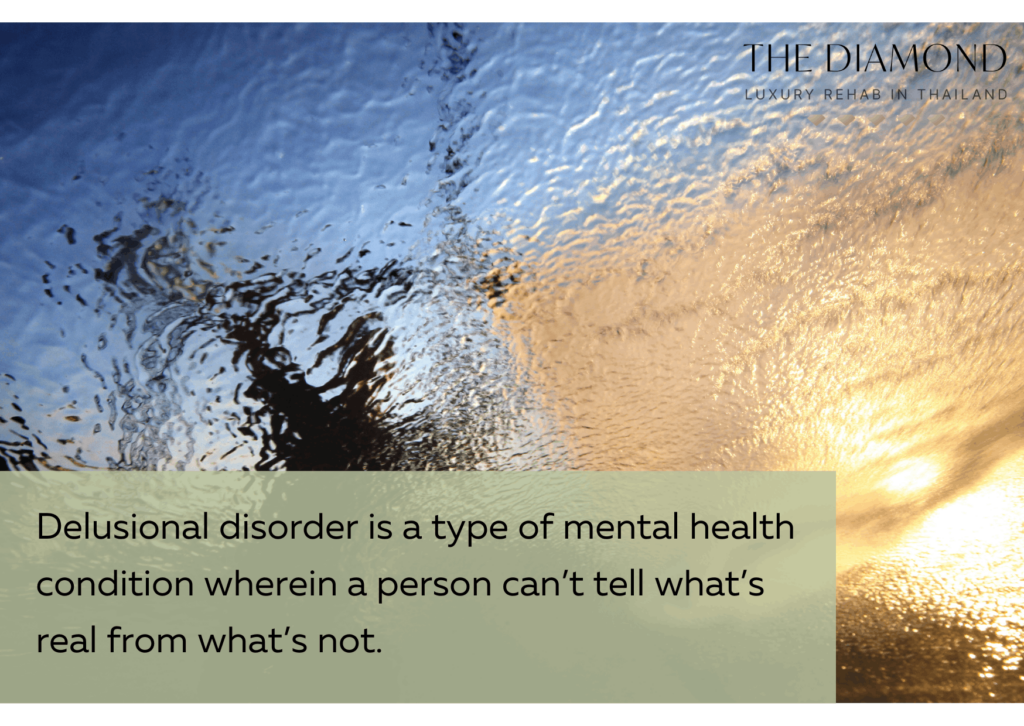
As reported by Schizophrenia Bulletin, delusional disorder is characterized by at least one month of delusions without other psychotic symptoms. That said, people with this disorder can have hallucinations, but this symptom isn’t prominent. In delusional disorder, hallucinations are related to the delusional theme only. For instance, a person who believes they have a problem with their odor may have hallucinations with bad smells. Someone whose delusions are related to hearing or seeing something will have hallucinations involving these senses and the specific belief around which delusions revolve.
The delusional disorder may cause or lead to hallucinations due to abnormalities in certain parts of the brain. An imbalance in levels of neurotransmitters could also lead to hallucinations. Stress can also trigger symptoms of delusional disorder as well as alcohol use. Social isolation is also a factor in triggering symptoms of delusional disorder.
4. Brief psychotic disorder
A brief psychotic disorder is defined as the presence of one or more psychotic symptoms with a sudden onset and full remission within a month. People with brief psychotic disorders usually experience hallucinations and delusions. There are three types of this psychotic disorder. They are brief psychotic disorders with an obvious stressor, without an obvious stressor, and with postpartum onset.
The exact cause of a brief psychotic disorder and why it leads to hallucinations is unknown. Some people may have a genetic predisposition to it because the disorder is more common among people with a family history of depression and bipolar disorder.
Also, poor coping skills could lead to symptoms of a brief psychotic disorder such as hallucinations. People who experienced trauma may develop unhealthy coping mechanisms as an escape or defense against stressful or frightening situations. This may lead to delusions and hallucinations.
5. Schizophreniform disorder
Schizophreniform disorder is a psychotic disorder indicated by symptoms similar to those of schizophrenia. The only difference is that schizophrenia lasts for life, whereas symptoms of schizophreniform disorder last between one and six months. This mental health condition affects how people think, act, express emotions, perceive reality, and relate to others.
People with schizophreniform disorder tend to experience hallucinations, delusions, disorganized speech, odd or strange behavior, and other symptoms.
It’s not entirely clear how schizophreniform disorder relates to hallucinations. One potential theory is that genetics could be the reason. The tendency to develop symptoms of this disorder may be passed from parents to children. The imbalance of neurotransmitters is also a potential reason that explains how schizophreniform disorder leads to hallucinations. Highly stressful events and poor social interactions are also linked to the development of schizophreniform disorder and its symptoms.
6. Schizoaffective disorder
Schizoaffective disorder is a condition wherein a person experiences symptoms of both mood and psychotic disorders within one episode. That’s exactly what the name of this disorder states; it consists of the words shizo– (referring to psychotic symptoms) and –affective (referring to mood symptoms).
People tend to experience schizoaffective disorder differently. In most cases, patients with schizoaffective disorder experience symptoms such as hallucinations, delusions, bizarre or unusual behavior, symptoms of depression, and symptoms of mania.
Schizoaffective disorder may have a genetic component. That means a person may have a genetic predisposition to develop symptoms of this mental illness, including hallucinations. Having a first-degree relative (parent or sibling) with schizoaffective disorder increases the risk of these symptoms. The same applies to a family history of other disorders such as schizophrenia and bipolar disorder. A person is more likely to have hallucinations if their family members have mental health disorders that cause hallucinations as well.
What are the symptoms of Hallucinations?
Symptoms of hallucinations may vary from one patient or type to another. They are listed below:
- Hearing sounds that other people can’t see e.g. banging of doors, music, footsteps
- Seeing people or things that don’t exist
- Feeling sensations across the body like something that crawls up and down the skin
- Hearing voices
- Smelling something although others can’t
- Tasting something others can’t
- Feeling like the body is moving when it’s not
What are the types of Hallucinations?
There are five types of hallucinations i.e. hallucinations that affect all five senses. Psychiatrists, however, have defined other types of hallucinations too. They are listed below:
- Auditory hallucinations: the most common type of hallucination refers to hearing sounds or voices that other people can’t. For example, a person may feel as if someone is speaking to them or telling them to do certain things. The voice may be neutral, warm, or angry.
- Visual hallucinations: the second most common type of hallucinations, affects the sense of sight and involves seeing colors, shapes, people, or items that aren’t real.
- Olfactory hallucinations: less common than the abovementioned types of hallucinations, it refers to smelling something that doesn’t have a physical source. Olfactory hallucinations don’t necessarily indicate a person is bound to feel bad scents or smells. They can also include scents that are enjoyable, such as the smell of flowers.
- Tactile hallucinations: this type of hallucination affects the sense of touch, and it involves feeling sensations as if a person is being touched even though they’re not. A good example is feeling like bugs are crawling under the skin.
- Presence hallucinations: feeling like someone is in the room or nearby even though they’re not.
- Gustatory hallucinations: the rarest type of hallucination refers to having a taste in the mouth that doesn’t have a source. A good example is having a metallic taste in the mouth. Gustatory hallucinations are relatively common in people with epilepsy.
- Proprioceptive hallucinations: feeling as if the body is moving or the limbs are separate from the body, even though the reality is different.
- Hypnopompic hallucinations: the type of sleep-related hallucinations that occur as a person is waking up from sleep.
- Hypnagogic hallucinations: the type of sleep-related hallucinations that happen when a person is falling asleep.
How are Hallucinations diagnosed?
Hallucinations are diagnosed after a thorough assessment of a person’s physical and psychological health to determine the underlying cause. Keep in mind hallucination is not a standalone disease, but a symptom that different mental and some physical conditions cause.
The doctor will ask questions about symptoms, lifestyle habits, medical history, and family history to get as much information as they can. The healthcare provider will perform a physical exam and order some tests to determine whether a specific health problem, such as some neurologic condition, is behind hallucinations.
For that reason, the patient may need to do a blood test that checks for metabolic or toxic causes of hallucinations, an electroencephalogram (EEG) to check for abnormal electrical activity in the brain and determine the presence of seizures, and an MRI to look for structural brain issues.
Based on the results of these tests, the doctor will be able to diagnose the condition that causes hallucinations. Sometimes these tests show no problems or abnormalities, which indicates the cause of hallucinations is psychological. When that happens, the patient is referred to a psychiatrist for psychiatric evaluation.
Psychiatric evaluation involves completing a questionnaire or answering questions about symptoms, hallucinations, thoughts, behaviors, and emotions. The psychiatrist may ask questions about personal or family history of mental health problems. They may also ask for permission to speak to a family member to get a better insight into the patient’s behaviors.
In order to diagnose the psychological cause of hallucinations, the mental health professional will look into DSM-5 and check whether patients meet the diagnostic criteria. For example, if a patient meets the criteria for bipolar disorder, that will be their diagnosis. If they meet the criteria for schizophrenia, it would imply this psychological condition causes hallucinations in their case.
How are Hallucinations prevented?
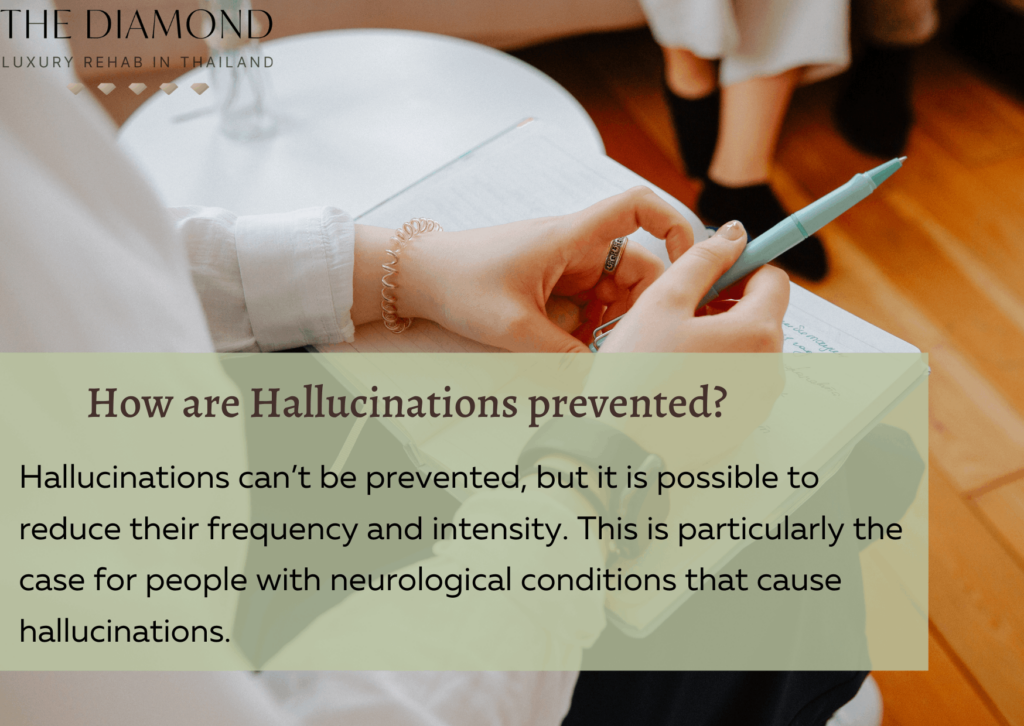
Hallucinations can’t be prevented, but it is possible to reduce their frequency and intensity. This is particularly the case for people with neurological conditions that cause hallucinations.
First, it is important to have good lighting and take part in stimulating activities in the evening. Second, make sure to check for sounds that may be misinterpreted such as noise from an appliance or TV.
Third, it’s useful to look for correct lighting that casts shadows, distortions, or reflections. Fourth, it is necessary to try covering mirrors with a cloth or removing them, if a person believes they’re looking at a stranger.
Fifth, self-help strategies can help cope with hallucinations and thereby reduce their severity. These strategies include regular exercise, talking with other people, reading, listening to music, practicing mindfulness, and maintaining routines in daily life.
What are the possible treatments for Hallucinations?
Possible treatments for hallucinations depend on the underlying cause. A person with schizophrenia and someone with Parkinson’s disease don’t have the same treatment protocol for their hallucinations. Treating the cause of hallucinations helps manage them as well. Potential treatments for hallucinations are listed below:
- Medications: in many cases, doctors prescribe medications as the first-line treatment option for hallucinations. The exact medications depend on the condition that caused them. For instance, people who are hallucinating during alcohol or drug withdrawal may receive medications that calm their nervous system and thereby treat hallucinations. Patients with Parkinson’s disease or Alzheimer’s disease may need different medications. Atypical antipsychotics, acetylcholinesterase inhibitors or antidepressants may be used in Parkinson’s disease when appropriate, according to a paper from the Expert Review of Neurotherapeutics. Patients with schizophrenia may receive a prescription for antipsychotic medications to treat their hallucinations. These medications work by decreasing and controlling many symptoms of psychosis, including hallucinations.
- Psychotherapy: behavioral therapy is an important aspect of treating hallucinations, especially in patients with mental health disorders such as schizophrenia. There are different types of psychotherapy, but the most effective approach is cognitive-behavioral therapy (CBT). The goal of CBT, in this case, is to change the way a person with hallucinations thinks about and responds to these sensory experiences. The therapy helps make hallucinations less distressing and reduces their impact on a person’s quality of life. A paper from the Schizophrenia Bulletin found that including psychotherapy in addition to routine care is more beneficial than routine care alone in the treatment of psychotic symptoms such as hallucinations.
What are the risk factors for Hallucinations?
Risk factors of hallucinations are circumstances that increase one’s likelihood of developing this sensory experience. Not every person with these risk factors is bound to develop hallucinations, they’re more complicated than that. Common risk factors for hallucinations are listed below:
- Family history of psychotic disorders
- History of mental health conditions such as schizophrenia or bipolar disorder
- Alcohol and drug abuse
- Taking certain medications such as some pain medications, antipsychotic and anti-seizure drugs
- General anesthesia during surgery
- Older age at the onset of neurodegenerative conditions such as Parkinson’s disease
- Narcolepsy (excessive daytime sleepiness)
- Continuous lack of sleep
- Hearing impairment or vision loss
- Having PTSD after a traumatic experience
What triggers Hallucinations?
Many things can trigger hallucinations including insomnia, prolonged stress, and extremely high fever. Some drugs and substances can also trigger hallucinations. Good examples are marijuana and mind-altering drugs such as ecstasy, PCP, and LSD.
Other drugs that may trigger hallucinations include cocaine, amphetamines, opium, ketamine, and even alcohol.
Sometimes being “high” or under the influence of these substances can trigger hallucinations, but in some cases, people may hallucinate when being off drugs.
Mind-altering or hallucinogenic drugs are the main triggers of hallucinations among people who aren’t mentally ill or don’t have a physical health problem such as Alzheimer’s disease.
Can Hallucinations be cured?
Yes, hallucinations can be cured but it depends on the underlying cause. For instance, if a person is hallucinating due to withdrawal from alcohol or some drugs, proper treatment can help cure them. When hallucinations result from conditions such as schizophrenia, dementia, or Parkinson’s disease, it may not be possible to cure them entirely. In these cases, the treatment can help control hallucinations by reducing their intensity and frequency.
What is the difference between a hallucination and a delusion?
The difference between a hallucination and a delusion is that the latter is not a sensory experience. Both hallucination and delusion depict things that aren’t real, but their nature is different. Delusions are beliefs that are obviously false and not based on any evidence that would support them. On the other hand, hallucinations are sensory experiences that a person perceives as real when they’re not.
For example, hallucinations can involve hearing someone talking even when there’s nobody around or seeing something that isn’t there. Delusions can involve thinking someone is in love with you even when they’re not. Some people may think they are being controlled or spied on.
Sometimes, delusions and hallucinations can occur together. That happens in some cases of schizophrenia, for example.

